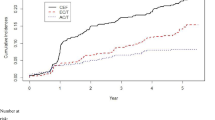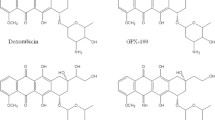Summary
Anthracyclines and anthracenediones are important oncotherapeutics; however, their use is associated with irreversible and cumulative cardiotoxicity. A novel aza-anthracenedione, pixantrone (BBR 2778), was developed to reduce treatment-related cardiotoxicity while retaining efficacy. This study evaluates the cumulative cardiotoxic potential of pixantrone compared with equiactive doses of doxorubicin and mitoxantrone in both doxorubicin-pretreated and doxorubicin-naïve mice. CD1 female mice were given doxorubicin 7.5 mg/kg (once weekly for 3 weeks) followed 6 weeks later by either sterile 0.9% saline, doxorubicin 7.5 mg/kg, pixantrone 27 mg/kg, or mitoxantrone 3 mg/kg (once weekly for 3 weeks). A second group of CD1 female mice were given 2 cycles of either sterile 0.9% saline, pixantrone 27 mg/kg, doxorubicin 7.5 mg/kg, or mitoxantrone 3 mg/kg (once weekly for 3 weeks). Animals were sacrificed at different time points for histopathologic examination of the heart. In the doxorubicin-pretreated mice, further exposure to doxorubicin or mitoxantrone resulted in a significant worsening of pre-existing degenerative cardiomyopathy. In contrast, pixantrone did not worsen pre-existing cardiomyopathy in these animals. Only minimal cardiac changes were observed in mice given repeated cycles of pixantrone, while 2 cycles of doxorubicin or mitoxantrone resulted in marked or severe degenerative cardiomyopathy. These animal studies demonstrate the reduced cardiotoxic potential of pixantrone compared with doxorubicin and mitoxantrone. Exposure to pixantrone did not worsen pre-existing cardiomyopathy in doxorubicin-pretreated mice, suggesting that pixantrone may be useful in patients pretreated with anthracyclines.





Similar content being viewed by others
References
Steinherz LJ, Steinherz PG, Tan CT, Heller G, Murphy ML (1991) Cardiac toxicity 4 to 20 years after completing anthracycline therapy. JAMA 266:1672–1677
van Dalen EC, van der Pal HJ, Bakker PJ, Caron HN, Kremer LC (2004) Cumulative incidence and risk factors of mitoxantrone-induced cardiotoxicity in children: a systematic review. Eur J Cancer 40:643–652
Lefrak EA, Pitha J, Rosenheim S, Gottlieb JA (1973) A clinicopathologic analysis of adriamycin cardiotoxicity. Cancer 32:302–314
Von Hoff DD, Layard MW, Basa P, Davis HL Jr, Von Hoff AL, Rozencweig M, Muggia FM (1979) Risk factors for doxorubicin-induced congestive heart failure. Ann Intern Med 91:710–717
Swain SM, Whaley FS, Ewer MS (2003) Congestive heart failure in patients treated with doxorubicin: a retrospective analysis of three trials. Cancer 97:2869–2879
Beggiolin G, Crippa L, Menta E, Manzotti C, Cavalletti E, Pezzoni G, Torriani D, Randisi E, Cavagnoli R, Sala F, Giuliani FC, Spinelli S (2001) Bbr 2778, an aza-anthracenedione endowed with preclinical anticancer activity and lack of delayed cardiotoxicity. Tumori 87:407–416
Corbett TH, Griswold DP Jr, Roberts BJ, Schabel FM Jr (1981) Absence of delayed lethality in mice treated with aclacinomycin A. Cancer Chemother Pharmacol 6:161–168
Herbrecht R, Borchmann P, Wilhelm M, Morschhauser F, Hess G, Kutz K, Comis S, Laffranchi BL, Engert A. Preliminary phase II study results of BBR2778 in combination with cyclophosphamide, vincristine, and prednisone in patients with relapsed aggressive non-Hodgkin's lymphoma. Blood 104:Abstract 2489
Bertazzoli C, Bellini O, Magrini U, Tosana MG (1979) Quantitative experimental evaluation of adriamycin cardiotoxicity in the mouse. Cancer Treat Rep 63:1877–1883
Bellini O, Tosana MG, Bertazzoli C (1984) Comparison of the cardiotoxicity of anthracyclines in two experimental models in mice. Drugs Exp Clin Res X:91–95
Kremer LC, van Dalen EC, Offringa M, Ottenkamp J, Voute PA (2001) Anthracycline-induced clinical heart failure in a cohort of 607 children: long-term follow-up study. J Clin Oncol 19:191–196
Steinherz LJ, Steinherz PG, Tan CT, Heller G, Murphy ML (1991) Cardiac toxicity 4 to 20 years after completing anthracycline therapy. JAMA 266:1672–1677
Sorensen K, Levitt GA, Bull C, Dorup I, Sullivan ID (2003) Late anthracycline cardiotoxicity after childhood cancer: a prospective longitudinal study. Cancer 97:1991–1998
Jensen BV, Skovsgaard T, Nielsen SL (2002) Functional monitoring of anthracycline cardiotoxicity: a prospective, blinded, long-term observational study of outcome in 120 patients. Ann Oncol 13:699–709
Limat S, Demesmay K, Voillat L, Bernard Y, Deconinck E, Brion A, Sabbah A, Woronoff-Lemsi MC, Cahn JY (2003) Early cardiotoxicity of the CHOP regimen in aggressive non-Hodgkin's lymphoma. Ann Oncol 14:277–281
Author information
Authors and Affiliations
Rights and permissions
About this article
Cite this article
Cavalletti, E., Crippa, L., Mainardi, P. et al. Pixantrone (BBR 2778) has reduced cardiotoxic potential in mice pretreated with doxorubicin: Comparative studies against doxorubicin and mitoxantrone. Invest New Drugs 25, 187–195 (2007). https://doi.org/10.1007/s10637-007-9037-8
Published:
Issue Date:
DOI: https://doi.org/10.1007/s10637-007-9037-8




